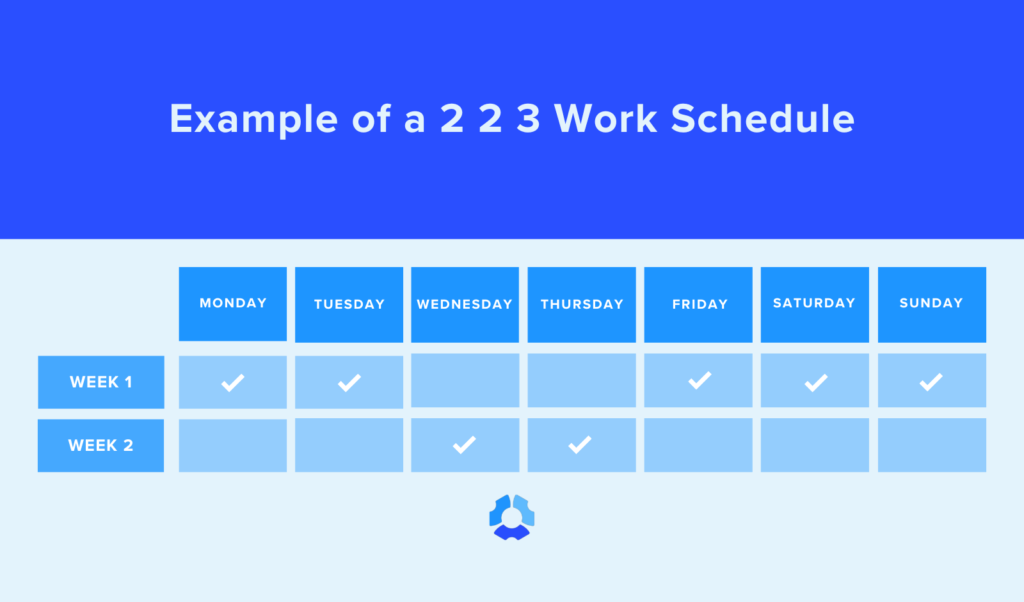A surprising 16% of US wage and salary workers find themselves navigating non-standard schedules.
The swing shift schedule stands out among these unique work patterns, orchestrating a seamless transition from day to night for countless professionals across various industries.
This comprehensive guide delves into the intricacies of swing shifts, swing shift hours, and how to utilize swing shifts in your business.
Boost your team’s efficiency with Hubstaff's productivity tools
What is a swing shift schedule?
Swing shift schedules are pretty straightforward. Imagine the hands of a clock swinging from afternoon into night — that’s essentially what a swing shift schedule is. It is not your usual morning shift to afternoon work stretch.
Swing shifts connect busy days and quiet nights. Swing shift hours start in the late afternoon, around 2 pm to 4 pm, and continue until midnight or even 1 am.
Why swing into swing shifts?
Swing shifts keep the world spinning even after most people have called it a day. Health care, manufacturing, transport, etc. — countless industries rely on swing shifts for seamless, 24/7 operation.
But here’s the thing: A swing shift schedule can be tricky to manage.
Helpful Tip: Utilize Hubstaff as your ally for effortless employee scheduling software tracking, organizing, and optimizing swing shifts. It goes beyond simply clocking in and out, focusing on efficiently covering shifts, and reclaiming more hours in your day.
How is a swing shift schedule different from a rotating shift schedule?
Swing shift hours are usually fixed shifts. The swift shift starts later in the day and extends into the night shift. This provides a consistent work schedule for employees to plan around.
On the other hand, a rotating shift schedule involves changing schedules regularly, including a morning shift, an afternoon shift, and a night shift. Rotating shifts can make it challenging for team members to maintain a stable routine and adjust to different sleep patterns.
Which industries hire swing shift workers?
| Industry | How they utilize a swing shift schedule | Swing shift schedule example |
| Retail | Accommodate peak hours and provide customer service during the evenings and weekends. | 12:00 pm – 9:00 pm |
| Health care | Round-the-clock patient care and emergency services. | 7:00 pm – 7:00 am |
| Manufacturing | Maintain continuous production and meet tight deadlines. | 3:00 pm – 11:00 pm |
| Logistics | Handle shipments and deliveries at all hours. | 10:00 pm – 6:00 am |
| Call centers | Provide customer support across different time zones. | 2:00 pm – 10:00 pm |
| Hospitality | Serve guests during late-night check-ins and ensure smooth operations. | 4:00 pm – 12:00 am |
| Emergency services | Respond to crises and emergencies 24/7. | 6:00 am – 6:00 pm |
Types of swing shifts with examples
There are many different types of work schedules. Understanding different types of swing shift schedule options is crucial for effective workforce management in flexible scheduling.
Here are some common types of swing shifts:
- Fixed shift: A fixed swing shift would have consistent late-day hours. For example, swing shift employees always work from 3 pm to 11 pm, providing a steady routine.
- Rotating swing shift schedule: The swing shift workers have weekly rotating shifts, allowing for a fair distribution of workload among employees. For example, a swing shift employee might work from 2 pm to 10 pm one week and then transition to a night shift from 4 pm to midnight the following week.
- Split shift: Swing shift employees split their day into two working swing shifts. For example, swing shift workers may work from 11 am to 3 pm and then from 6 pm to 10 pm.
What is a 2 2 3 swing shift?
A 2 2 3 swing shift is typical in constant operation industries (for example, law enforcement). You typically work for two days, take two days off, work for three days, take two days off, work for two days, then take three days off. Repeats every two weeks.
Example of a 2 2 3 swing shift hours:

How does a 12-hour swing shift work?
Understanding 12-hour swing shifts is about knowing that employees work a full-day shift, transitioning from day and night shifts. Usually, they work four days and then have four days off, giving them enough rest between longer work periods. This model is beneficial as it only involves two swing shift changes, reducing complexity and potential miscommunications.
This continuous coverage ensures uninterrupted business operations.
Pros and cons of swing shift schedules
Swing shifts are like puzzles — fitting work hours into your day in a different way. They’re really common in hospitals, factories, and places that help us when our normal day is done.
| Pros of swing shift schedules | Cons of swing shift schedules |
| More free time: Able to run errands or attend appointments easily | Social life struggle: Difficulty in syncing schedules with friends |
| Sleeping in: Ideal for individuals not inclined towards mornings | Health habits: Challenges in maintaining consistent meal and sleep routines |
| Money, maybe: Potential for additional pay due to non-standard hours | Parenting puzzle: Difficulty in finding suitable childcare during odd hours |
| Less traffic: Off-peak travel times reduce congestion on the roads | Body clock blues: Disruption of natural body clock and sleep patterns |
| Learning and growth: Opportunity to acquire new skills and leadership experience | Iffy for teams: Coordination becomes challenging when team members work on different schedules |
Swing Shifts Simplified with Hubstaff

Think of Hubstaff as your command center for swing shift schedules. With real-time tracking, you always know who’s on the clock, keeping things ticking without a hiccup. Our comprehensive dashboard translates hours into actionable data, driving growth decisions.
Are you worried about scheduling your swing shifts? Get rid of your weekly work schedule template and start leveraging technology. Hubstaff’s dynamic rostering adjusts on the fly — allowing you to update a swing shift easily. And communication within teams? As smooth as the transition from day and night shifts with our in-app messaging.
Adapting to swing shift schedules: Tips for employers and employees
For employers
Navigating a swing shift can be challenging for employers, but they can boost productivity and well-being with the right approach. Employers can help by providing amenities like restful spaces, using day and night shifts to avoid burnout, and keeping open communication to address any concerns within the team.
For employees
For employees, self-care is paramount, especially if you have many night shifts. Establish a regular sleep cycle with blackout curtains and white noise machines, strategically use caffeine, and balance work with relaxation through exercise and hobbies. It’s crucial to sustain work-life balance.
What are the impacts of swing shifts on workers’ health and well-being?
The irregular nature of these swing shifts can mess with sleep and cause fatigue and stress. Balancing work and family becomes tricky if you work many night shifts, impacting personal relationships and mental well-being.
Using tools like Hubstaff can help. It manages shifts efficiently, ensuring fair distribution and enough rest between them. Hubstaff lets employees see and swap a swing shift easily, promoting a better work-life balance. Flexibility keeps the workforce healthy and happy and boosts overall productivity — a win for any industry relying on swing shifts.
Try Hubstaff today for a positive change in managing swing shifts. Your workforce and your bottom line will appreciate it.
What are the legal regulations or company policies governing swing shift schedules?
Employers must understand federal and state labor laws to navigate the legal side. The Fair Labor Standards Act (FLSA) sets the stage, requiring overtime pay beyond 40 hours a week. While not specific to swing shifts, the FLSA lays the foundation for fair compensation for non-traditional hours. Some states have additional rules, like extra pay for swing shifts or mandatory rest periods between shifts for worker well-being.
Companies aiming for excellence often go beyond legal basics for swing shifts. They may offer extra pay for a swing shift or better health benefits to meet swing shift demands in the evening hours.
Hubstaff shift scheduling is a helpful tool that ensures easy compliance with these rules and gives employees control over their schedules. This not only keeps things legal but also boosts morale and productivity. Optimize your swing shift management with Hubstaff for a thriving, compliant, and productive work environment.
Swing into action with Hubstaff
Implement Hubstaff and witness firsthand the transformation of your swing shifts from a potential logistical nightmare into a strategic asset. Our platform is not simply an application; it’s a catalyst for maximizing the utilization of every moment of your swing shift schedule.
Discover the Hubstaff difference: Embrace the future of swing shifts.
Most popular
The Fundamentals of Employee Goal Setting
Employee goal setting is crucial for reaching broader business goals, but a lot of us struggle to know where to start. American...
Data-Driven Productivity with Hubstaff Insights: Webinar Recap
In our recent webinar, the product team provided a deep overview of the Hubstaff Insights add-on, a powerful productivity measurem...
The Critical Role of Employee Monitoring and Workplace Security
Why do we need employee monitoring and workplace security? Companies had to adapt fast when the world shifted to remote work...
15 Ways to Use AI in the Workforce
Whether through AI-powered project management, strategic planning, or simply automating simple admin work, we’ve seen a dramatic...




